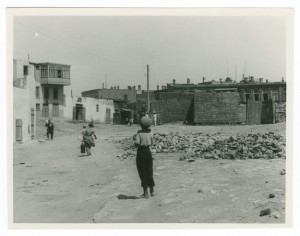Everyone has a childhood. Therefore, the history of childhood is accessible to students of history and intrinsically compelling. It creates spaces for students to question implicit assumptions about both history and childhood. More history courses, I argue, should include a reading or project relating its contents to the burgeoning field of childhood studies. While the history of childhood is a young field (pun intended), it is a dynamic and growing one. Inspired by discussions with Karl Qualls, Julie deGraffenried and other participants in the recent Russian Children’s History Workshop about the field of childhood studies, here I will share what I have done at the University of North Carolina at Chapel Hill (Part I) and suggest some ideas and resources (Part II).
Part I: Case Study: RUES 699 Kids, Communists and Capitalists: Twentieth-century Childhood in Comparative Perspective
It would be hard to imagine a subject more difficult to teach—or more rewarding—than the history of childhood. Truly interdisciplinary, the history of childhood must necessarily draw upon anthropology, art history, biology, demography, developmental psychology, law, literature, philosophy, and sociology, among other disciplines. Unlike courses that can be organized in a purely chronological fashion, the history of childhood’s multidisciplinary character means that courses must combine chronology with topical approaches–including such topics children’s culture, diversity and inequality, children and war, friendship and peer relationships, and biological realities and cultural variation– and ongoing debates, such as how much childhood has changed over time and how extensively children’s developmental stages have varied.
—Steven Mintz, “Teaching the History of Childhood”
I not only accept Steven Mintz’s challenge, but add an additional layer: I teach the comparative history of childhood. “Over the course of the twentieth century,” I write, “Russian children—like their American counterparts—grappled with far-reaching changes, with each decade or era characterized by diverse childhood experiences. Russia’s children played, attended school, ate sweets, acted in plays, and learned to ballroom dance. But, for many of them, the twentieth century was an extraordinarily brutal one. Like adults, children faced family disruption, starvation, arrest, disease, and death.”[1] By offering a unique side-by-side consideration of Soviet and American childhood and children’s culture over the “long twentieth century,” my course examines how adults sought to control children’s lives (this theme resonates with students) as well as how children experienced historic and quotidian moments.
Ultimately, I seek to make the familiar (for most of my students, childhood in America) strange and the strange (the history of Russian childhood) familiar. Students enrolled in my seminar engage in a comparative and interdisciplinary dialogue about children and youth. Together, we study children in the context of historic upheavals–the Great Depression, the Gulag, and the Great Patriotic War or World War II. We explore coming of age on the two sides of the Cold War; the centrality of school in children’s lives; the growth of consumerism and material culture in the second half of the twentieth century; state and market efforts to shape children’s leisure activities; and inequality and the diversity of minority experiences.
Here are some of the “big questions” that we consider: What was it like to grow up in the Soviet Union? Was it intrinsically different from growing up in the United States? In what ways do geography, class, gender and historical era shape childhood? Who gets to define childhood? What counts as a “good” or normal childhood? How did the understanding and experience of childhood shift from decade to decade?
So who takes this course? Given its institutional home in the Curriculum in Russian and East European Studies and my affiliation with the Department of History, once would expect graduate and undergraduate students affiliated with the Curriculum in Russian and East European Studies, Department of History, and Department of Germanic and Slavic Languages and Literatures to enroll and they do. In addition, students from the following campus units also took the course: Curriculum in Global Studies; Curriculum in Peace, War, and Defense; the Department of Public Policy; Gillings School of Global Public Health; and the School of Education, including the School Administration program. One student, a native of Russia who emigrated at an early age, expressed a desire to “better understand her parents and grandparents.” The diverse backgrounds of the students not only makes for lively class discussions; it also attests to the broad interest in and appeal for interdisciplinary studies of childhood and the history of childhood.
My course strives to prepare global citizens who are adept at thinking in a comparative framework. Importantly, students cultivate an understanding of young people’s complicated roles and relationships in the development of modern societies and cultures as they gain familiarity with some of the scholarly research and writing on children and childhood.
[1] Jacqueline Olich, “The Russianists Love Their Children, Too,” The Journal of the History of Childhood and Youth Volume 1, Number 3, Fall 2008 pp. 445.
